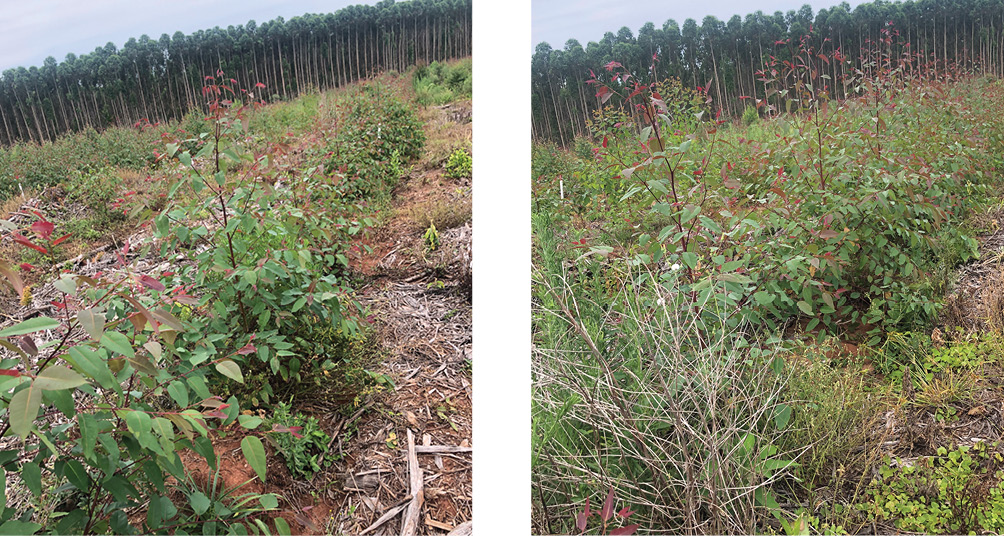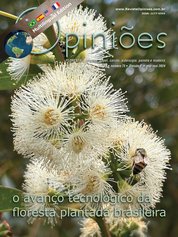Aldo Merotto Junior
Professor de Herbologia e para a Pós-graduação em Fitotecnia da UFRGS
OpCP75
Evolução da silvicultura no manejo da matocompetição
A silvicultura realizada mundialmente e principalmente no Brasil passou por grandes evoluções nos últimos anos. O Brasil possui características favoráveis a esta atividade e os níveis de produtividade obtidos recentemente demonstram as vantagens do Brasil para produção de florestas plantadas. As plantas daninhas coexistem com as atividades humanas e possuem grande impacto na atividade da silvicultura. O controle de plantas daninhas passou por grandes revoluções nos últimos anos nas situações de lavouras de produções de grãos.
Na silvicultura, estas mudanças são mais recentes, mas chegaram com grande intensidade e apontam para grandes evoluções em um futuro próximo. A silvicultura possui características particulares em relação a outras atividades em relação ao controle de plantas daninhas.
Por um lado, têm-se o efeito de cultivo perene de larga escala temporal e até recentemente a grande tolerância pelos técnicos envolvidos à presença e a resultados de controle de plantas daninhas com efeito apenas satisfatório.
Por outro lado, a operacionalização de produção a campo é impactada pela sistemática de engenharia da produção da indústria. Isto tem efeitos positivos em relação ao controle da qualidade das atividades desenvolvidas, mas possui dificuldades em relação a tratar de fenômenos biológicos associados a interação solo–herbicida–plantas daninhas–floresta plantada–atmosfera.
A evolução da silvicultura deve considerar esta interação e avançar na particularização do manejo não mais de acordo com receitas predeterminadas, mas com base em levantamentos específicos e aplicação localizada de herbicidas ou outros métodos de controle. Diversos fatores estão envolvidos com esta necessidade.
Disponibilidade de herbicidas:
Os herbicidas recomendados para uso em silvicultura no Brasil eram em número restrito até recentemente e isto dificultava o melhor uso desta ferramenta de controle de plantas daninhas. No entanto, maior número de ingredientes ativos foram recentemente registrados, principalmente para os cultivos de eucalipto e em menor escala para pinus. Ainda existe grande carência de produtos registrados para outras espécies de plantios florestais como acácia, álamo, teca e outras espécies.
Existe necessidade que o setor florestal através das indústrias envolvidas ou de suas organizações cooperadas atuem junto aos órgãos do governo envolvidos com o registro de produtos fitossanitários e com as indústrias produtoras ou distribuidoras destes produtos para que novos herbicidas sejam disponibilizados. Em muitas destas companhias e órgãos governamentais ainda não existe a percepção da necessidade de disponibilização de ingredientes ativos mais modernos para melhoria do controle de plantas daninhas e maior sustentabilidade ambiental da atividade da silvicultura no Brasil.
Existe necessidade que o setor florestal através das indústrias envolvidas ou de suas organizações cooperadas atuem junto aos órgãos do governo envolvidos com o registro de produtos fitossanitários e com as indústrias produtoras ou distribuidoras destes produtos para que novos herbicidas sejam disponibilizados. Em muitas destas companhias e órgãos governamentais ainda não existe a percepção da necessidade de disponibilização de ingredientes ativos mais modernos para melhoria do controle de plantas daninhas e maior sustentabilidade ambiental da atividade da silvicultura no Brasil.
Novas tecnologias de aplicação:
Os recentes avanços da aplicação através de drones e da agricultura digital já estão impactando e deverão impactar ainda mais as atividades de controle de plantas daninhas em plantios florestais. Grande parte do início da utilização de drones para aplicação de herbicidas no Brasil foi iniciada em plantios florestais, principalmente como forma de substituição da aplicação através de pulverizadores costais que representam grande custo operacional e demanda de mão de obra.
A aplicação com drone tem-se tornado cada vez mais frequente no Brasil para aplicação de produtos fitossanitários em diversas culturas. Infelizmente observa-se que em muitas situações ocorrem problemas de qualidade de aplicação em função da priorização do rendimento operacional em detrimento do atendimento das condições ambientais e características técnicas particulares de cada equipamento em utilização. Este problema não atinge somente as aplicações em silvicultura, mas ocorrem também em outros cultivos.
Agricultura digital:
Um dos grandes avanços da agricultura digital é a identificação da variabilidade espacial, da presença de plantas daninhas através de sensores embarcados em veículos terrestres, drones, aeronaves ou satélites. Esta tecnologia tem particular aplicação na silvicultura e certamente representa uma grande evolução a ser desenvolvida neste setor.
O ciclo de produção de aproximadamente cinco a sete anos e a baixa ocorrência de tráfego de máquinas em plantios florestais resulta na ocorrência das plantas daninhas com grande desuniformidade em comparação com culturas de lavoura ou plantios perenes de frutas ou outras espécies. A desuniformidade existente em plantios florestais está associada à variabilidade de espécies, da densidade de infestação, da composição mista de espécies e do longo ciclo de produção.
Atualmente, esta variabilidade não é considerada em grande parte dos plantios florestais devido às dificuldades operacionais, e cópia de sistemas de controle de plantas daninhas e cultivos de lavoura onde as definições de escolha de produtos e doses são realizadas com base em poucas espécies de plantas daninhas e em similar estágio de desenvolvimento. No entanto, em plantios florestais a regra é desuniformidade de espécies, composição múltipla, densidade e estágio das plantas daninhas, solo e ambiente.
Porém, até recentemente mesmo que fosse possível, não fazia sentido a consideração desta variabilidade pois existiam poucos herbicidas disponíveis e formas de aplicação destes produtos. No entanto, as tecnologias de mapeamento prévio da infestação vegetal, características de solo, identificação de plantas daninhas em tempo real ou prévia, aplicação localizada com equipamentos terrestres ou drones estão em franco desenvolvimento.
Atualmente, esta variabilidade não é considerada em grande parte dos plantios florestais devido às dificuldades operacionais, e cópia de sistemas de controle de plantas daninhas e cultivos de lavoura onde as definições de escolha de produtos e doses são realizadas com base em poucas espécies de plantas daninhas e em similar estágio de desenvolvimento. No entanto, em plantios florestais a regra é desuniformidade de espécies, composição múltipla, densidade e estágio das plantas daninhas, solo e ambiente.
Porém, até recentemente mesmo que fosse possível, não fazia sentido a consideração desta variabilidade pois existiam poucos herbicidas disponíveis e formas de aplicação destes produtos. No entanto, as tecnologias de mapeamento prévio da infestação vegetal, características de solo, identificação de plantas daninhas em tempo real ou prévia, aplicação localizada com equipamentos terrestres ou drones estão em franco desenvolvimento.
A utilização destas ferramentas permitirá a definição de herbicidas e misturas, variação de dose e necessidade real de aplicação. Isto irá representar uma grande evolução no controle racional da matocompetição em silvicultura. O mapeamento prévio e a identificação em tempo real proporcionarão a implementação dos pilares do manejo integrado de plantas daninhas relacionados a períodos de competição e nível de dano econômico que possuem aplicabilidade limitada no manejo atual realizado em área total e calendarizado.
Aperfeiçoar o manejo atualmente realizado:
A implementação das atuais medias de controle de plantas daninhas possui necessidades de melhorias em diversas áreas de plantios florestais. Por exemplo, a dessecação pré-plantio deve ser considerada como uma atividade chave. Atualmente esta operação é realizada, em geral, através de apenas uma aplicação e muitas vezes implementada, logo antes do momento do plantio.
Em muitas áreas existe um longo período entre à colheita e o plantio, o que favorece o estabelecimento de plantas daninhas. No caso de plantas daninhas perenes, o preparo do solo irá resultar em fragmentação de estruturas com capacidade reprodutiva que irão retomar o crescimento após o novo plantio. Esta situação, aliada à ocorrência de múltiplos fluxos de emergência e à ocorrência de plantas daninhas de difícil controle ao herbicida glifosato, resultam em uma característica peculiar em muitos plantios florestais relacionada a limitações de eficiência de controle na operação de dessecação.
Esta operação deve ser melhorada através da realização de operações sequenciais, com misturas de produtos sistêmicos na primeira e de contato na segunda aplicação, e de produtos adequados ao espectro de plantas daninhas existente em cada área.
Em muitas áreas existe um longo período entre à colheita e o plantio, o que favorece o estabelecimento de plantas daninhas. No caso de plantas daninhas perenes, o preparo do solo irá resultar em fragmentação de estruturas com capacidade reprodutiva que irão retomar o crescimento após o novo plantio. Esta situação, aliada à ocorrência de múltiplos fluxos de emergência e à ocorrência de plantas daninhas de difícil controle ao herbicida glifosato, resultam em uma característica peculiar em muitos plantios florestais relacionada a limitações de eficiência de controle na operação de dessecação.
Esta operação deve ser melhorada através da realização de operações sequenciais, com misturas de produtos sistêmicos na primeira e de contato na segunda aplicação, e de produtos adequados ao espectro de plantas daninhas existente em cada área.
Biotecnologia, resistência a herbicidas e métodos físicos:
Novas tecnologias de uso de herbicidas e novos problemas relacionados ao uso de herbicidas também já chegaram na silvicultura. A recente disponibilização de transgênicos resistentes ao herbicida glifosato na cultura do eucalipto demonstra a tecnificação desta atividade no Brasil. No entanto, a grande flexibilidade e eficiência deste herbicida não deve resultar em sua utilização única e contínua devido ao elevado risco de seleção de plantas daninhas resistentes ao herbicida glifosato.
Os problemas de plantas daninhas resistentes a este e a vários outros herbicidas já são existentes em plantios florestais no Brasil. Isto deve ser considerado quando do planejamento de uso de herbicidas e requer o diagnóstico da ocorrência de plantas daninhas resistentes. Este procedimento ainda não é realizado na quase totalidade dos plantios florestais e representa uma evolução necessária neste setor.
Os problemas de plantas daninhas resistentes a este e a vários outros herbicidas já são existentes em plantios florestais no Brasil. Isto deve ser considerado quando do planejamento de uso de herbicidas e requer o diagnóstico da ocorrência de plantas daninhas resistentes. Este procedimento ainda não é realizado na quase totalidade dos plantios florestais e representa uma evolução necessária neste setor.
O manejo adequado da resistência e da utilização de herbicidas caracteriza o manejo integrado de plantas daninhas que é baseado na racionalização de uso de herbicidas e de utilização de métodos alternativos de controle.
Atualmente está ocorrendo a retomada de desenvolvimento de métodos físicos de controle de plantas daninhas como por exemplo eletricidade, raio laser e flamejamento. Estes métodos ainda possuem elevado custo e possuem limitações de eficiência, mas representam possíveis evoluções do controle de plantas daninhas que poderão ser utilizadas na silvicultura.
Necessidade de evolução da percepção da matocompetição:
As recentes mudanças do controle da matocompetição na silvicultura no Brasil indicam que o sistema foi destravado em relação ao desenvolvimento e utilização de tecnologias modernas de controle de plantas daninhas. Diversos países com elevada produção silvícola possuem maior oferta de mão de obra e devido a isto ainda utilizam procedimentos antigos de manejo da vegetação. Em países com silvicultura desenvolvida como o Brasil a baixa disponibilidade de mão de obra e as necessidades de adequação a rígidos requerimentos ambientais está resultando em desenvolvimento de tecnologias de elevada complexidade.
Os elevados níveis de tecnificação da silvicultura devem ser acompanhados de mudanças na percepção dos problemas da matocompetição em relação aos prejuízos causados pelas plantas daninhas, forma de uso de herbicidas e demais ferramentas de controle. No entanto, a principal necessidade é a melhoria na percepção da variabilidade da interação solo–herbicida–plantas daninhas–floresta plantada–atmosfera em relação a tomada de decisão com base nas características de cada área em detrimento de simplificações de medidas fixas e preestabelecida.

Área com limitações de controle de plantas daninhas devido à baixa eficiência nas operações de dessecação e da aplicação de herbicida em pré-emergência (esquerda), e área livre de matocompetição resultante de controle adequado na dessecação e durante o crescimento inicial das plantas de eucalipto proporcionado pela escolha correta do herbicida aplicado em pré-emergência (direita).




